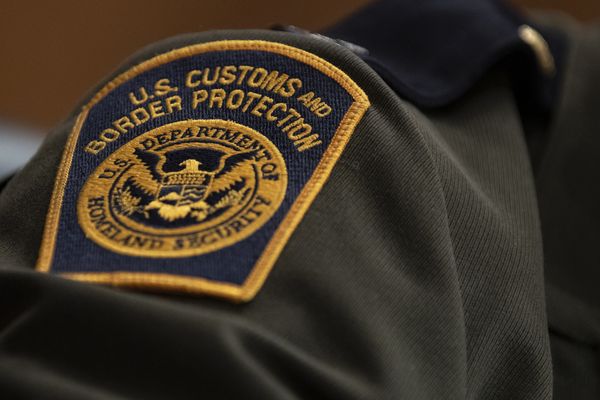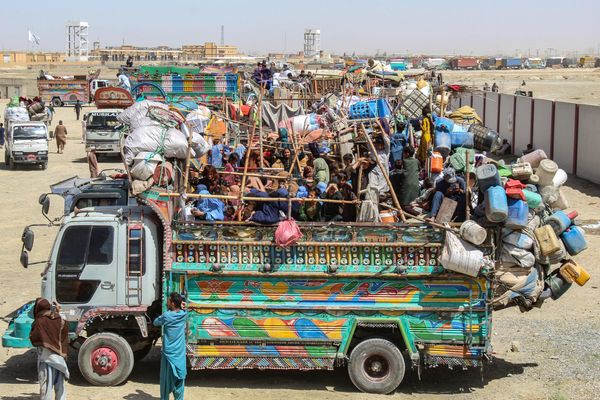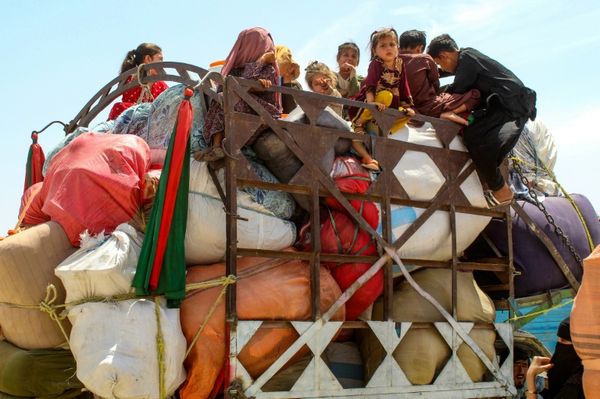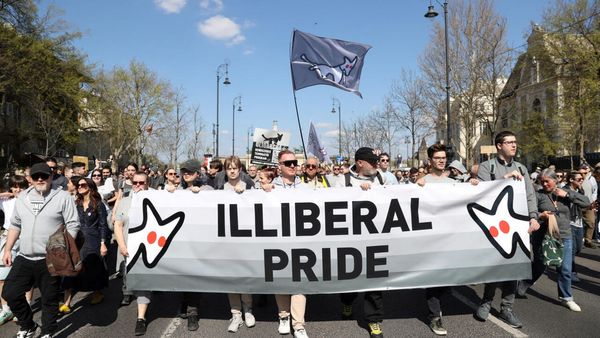
The National Gallery of Australia claims it covered Palestinian flags in a major exhibition after undertaking a security threat assessment, but critics say the decision was “rooted in political cowardice”.
The Guardian this week revealed two Palestinian flags on a large tapestry hanging in an exhibition currently showing in Canberra have been covered with white fabric.
The exhibition’s curator, founder of the Pacific Indigenous art collective SaVĀge K’lub, Rosanna Raymond, who is based in New Zealand, told the Guardian they were censored by the NGA. Despite trying to push back, Raymond said they reluctantly agreed to conceal references to the Palestinian flag.
The Guardian first contacted the NGA on Monday after being alerted to the altered artwork. The NGA refused to respond to a list of detailed questions, and a statement was only provided on Friday after the story went public.
While it remains unclear what prompted the NGA to cover the flags 10 days after the artwork was installed, or if the gallery was acting on a specific threat or complaint, in a statement a spokesperson said it was due to the risk posed by “sensitive content”.
“We acknowledge the SaVĀge K’lub artists were placed in a difficult position and we are grateful for their willingness to collaborate with us in a challenging and uncertain environment,” the spokesperson said.
“Consideration was given to past protest activity and vandalism at the National Gallery, the volatility of the environment and reported violence, vandalism and threats in Canberra, and across Australia at the time.
“The National Gallery assessed the risks and determined what we believed was the most appropriate action, in consultation with curator Rosanna Raymond MNZM and the SaVĀge K’lub artists.”
The large tapestry is part of the Te Paepae Aora’i – Where the Gods Cannot be Fooled exhibition, a group show by Pacific Indigenous art collective SaVĀge K’lub. It features a number of flags sewn together, including the Aboriginal flag and the words “justice now”, the Torres Strait Islander flag, the West Papua flag, along with other Pacific peoples’ symbols, insignia and social justice slogans.
‘Disgraceful act of censorship’
The executive director of National Association for the Visual Arts, Penelope Benton, said the right to artistic expression is fundamental, and any intervention that alters an artwork’s meaning must be carefully scrutinised.
“Covering elements of an artwork not only risks undermining the integrity of the artists’ message but also raises serious concerns about the pressures institutions face in balancing artistic freedom with external influences,” she said.
“Attempts to suppress or delegitimise freedom of expression – particularly within major cultural institutions – set a dangerous precedent.
“When artists and their works are censored, it creates an environment where difficult topics are avoided, weakening the ability of the arts to spark important conversations and challenge perspectives.”
The president of the Australian Palestine Advocacy Network, Nasser Mashni, said the move was part of a broader crackdown against those who stand for Palestinian rights. He dismissed claims the Palestinian flag posed a security risk.
“The NGA’s decision to police and erase Palestinian identity – by covering Palestinian flags in an artwork about social justice – is nothing less than a disgraceful act of censorship … rooted in political cowardice,” he said.
“The NGA must revoke this decision, apologise to the artists and the Palestinian community, and take a stand against Israel’s genocide, illegal occupation and apartheid.”
Raymond told the Guardian she was “absolutely horrified” when issues were raised in the days before the official opening. While the group “pushed back”, they ultimately agreed to a compromise and covered the targeted material.
“We pointed out if you’re covering the Palestinian flag, then what about the Aboriginal flag or the West Papua flag? The West Papua flag is illegal in West Papua – people are jailed for owning or flying one, but … they don’t worry about them,” she said.
“As Indigenous people we are very acutely aware of the damage of colonialism and neocolonialism, and what it looks like, but we haven’t had to experience it in such a way in the 21st century as our brothers and sisters in Palestine, in West Papua and in the Congo.”
The concealed items also included a “free Palestine” badge and fist pin which were deemed protest material.
The revelations have been met with concern within both the arts and Palestinian community, after a week of anger over Creative Australia’s decision to rescind the appointment of Lebanese-Australian artist Khaled Sabsabi, and curator Michael Dagostino, for the 2026 Venice Biennale.
‘This is what ensures democracy works’
The Brisbane-based artist Richard Bell, co-founder of Aboriginal art collective ProppaNOW, called the concealment of Palestinian flags and the sacking of Sabsabi a damning indictment on artistic freedom.
“It’s horrifying, everyone is horrified at the moment. This is censorship, what is happening is absolutely censorship,” he said.
“What on earth are they thinking?”
Several of Bell’s works hang in the NGA, including his 2020 piece The Truth Hurts, made during the Black Lives Matter protest, in which the words “WHITE LIES MATTER” appear on a coloured canvas.
Reflecting on the public show of solidarity with Sabsabi within the artistic community, Bell said he had never seen the Australian arts community so united.
“Artists bring things to the attention of the public that they’re not aware of … That’s really important, and this is what ensures democracy works,” he said.
“The role of the contemporary artist is to critique the ruling class.”
The arts minister, Tony Burke, has declined to comment.







